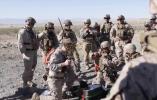פרישע איידיעס פון די אמעריקאנע מיליטער צו באמבארדירן אויפן פראנט


Land mines have long posed one of the most dangerous and persistent threats to troops in conflict zones. Hidden just beneath the surface, these explosive devices have the power to destroy vehicles, maim soldiers, and stall entire military operations. But over decades, the U.S. Army has developed innovative and increasingly effective methods to neutralize minefields and protect its forces—turning a deadly challenge into a manageable one through technology, engineering, and battlefield ingenuity.
In early conflicts, such as World War II and the Korean War, U.S. troops had little more than mine detectors and long prodding sticks to find and disarm mines by hand. This slow, risky method cost many lives and left soldiers highly vulnerable to ambushes.
The solution? Mechanization.
By the Vietnam War, engineers had begun using mine-clearing line charges (MICLICs)—rocket-propelled explosive cords that could clear a narrow lane through a minefield. The detonation set off any buried mines in its path, allowing troops or vehicles to safely pass through.
Today, the U.S. Army employs advanced systems like the M58 Mine Clearing Line Charge (MICLIC) and the Assault Breacher Vehicle (ABV), a modified M1 Abrams tank equipped with a plow and line charge launcher. These platforms can clear hundreds of meters of mines in seconds, offering mobility and protection in combat environments.
The MICLIC system, towed or mounted on vehicles, fires a rocket dragging a 350-foot explosive line that detonates upon landing. It's fast, powerful, and perfect for breaching narrow paths during fast-moving operations.
The ABV, on the other hand, is designed for tougher environments, capable of clearing mines and IEDs while leading armored columns. It not only fires its own MICLIC, but also uses ground plows and heavy armor to directly push through minefields.
What makes these systems so genius isn’t just the technology—it’s the integration of combat engineering into frontline tactics. These mine-breaching tools allow U.S. forces to:
This blend of firepower, speed, and safety gives the U.S. Army a critical edge in hostile environments.
Looking ahead, the Army is experimenting with autonomous mine detection drones, robotic breachers, and AI-powered mapping tools to detect, neutralize, or avoid mines altogether.
These technologies promise to make mine warfare even safer—potentially turning one of the deadliest obstacles on the battlefield into a manageable threat.
גאלערי
ווידעאס